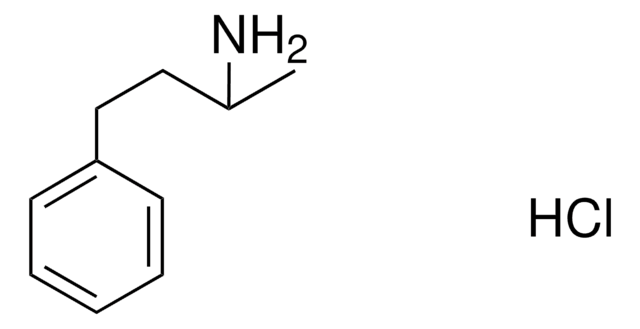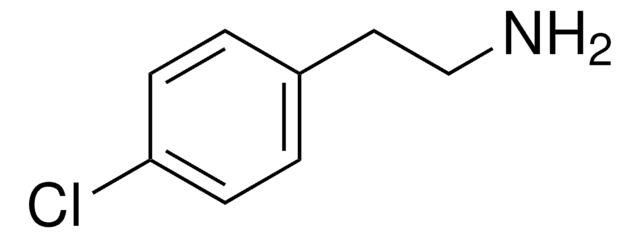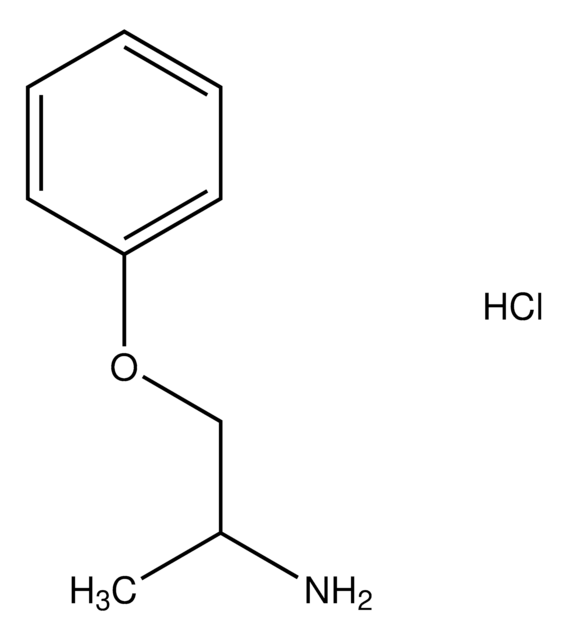추천 제품
분석
98%
형태
liquid
refractive index
n20/D 1.514 (lit.)
bp
228-232 °C (lit.)
density
0.922 g/mL at 25 °C (lit.)
SMILES string
CC(N)CCc1ccccc1
InChI
1S/C10H15N/c1-9(11)7-8-10-5-3-2-4-6-10/h2-6,9H,7-8,11H2,1H3
InChI key
WECUIGDEWBNQJJ-UHFFFAOYSA-N
유사한 제품을 찾으십니까? 방문 제품 비교 안내
관련 카테고리
신호어
Danger
유해 및 위험 성명서
Hazard Classifications
Acute Tox. 3 Dermal - Acute Tox. 3 Oral - Aquatic Chronic 3 - Eye Dam. 1 - Skin Corr. 1B
Storage Class Code
6.1A - Combustible acute toxic Cat. 1 and 2 / very toxic hazardous materials
WGK
WGK 2
Flash Point (°F)
208.0 °F
Flash Point (°C)
97.78 °C
개인 보호 장비
Faceshields, Gloves, Goggles, type ABEK (EN14387) respirator filter
시험 성적서(COA)
제품의 로트/배치 번호를 입력하여 시험 성적서(COA)을 검색하십시오. 로트 및 배치 번호는 제품 라벨에 있는 ‘로트’ 또는 ‘배치’라는 용어 뒤에서 찾을 수 있습니다.
R B Gilbert et al.
Journal of analytical toxicology, 19(2), 84-86 (1995-03-01)
A metabolite of labetalol that is responsible for previous reports of false-positive assays for amphetamines by thin-layer chromatography and immunoassay has been identified. The compound, 3-amino-1-phenylbutane (APB), an oxidative metabolite of labetalol, was initially identified in a patient's urine by
K Yeleswaram et al.
Drug metabolism and disposition: the biological fate of chemicals, 21(2), 284-292 (1993-03-01)
Labetalol causes significant maternal and fetal metabolic effects in pregnant sheep (Yeleswaram et al., J. Pharmacol. Exp. Ther. 262, 683-691 (1992)). This study was undertaken to investigate the contribution of skeletal muscles in the development of metabolic acidosis induced by
J Gal et al.
Research communications in chemical pathology and pharmacology, 62(1), 3-17 (1988-10-01)
Previous studies on the metabolic fate of antihypertensive agent labetalol in humans identified only conjugated metabolites of the drug and accounted for only a portion of the dose. In this study, urine samples obtained from three patients on chronic labetalol
K Yeleswaram et al.
Biological mass spectrometry, 21(11), 534-540 (1992-11-01)
A sensitive and selective assay has been developed for the identification and quantitation of 3-amino-1-phenyl butane (3-APB), a metabolite of labetalol, in biological fluids using electron impact gas chromatography/mass-selective detection. Samples were extracted with n-hexane, derivatized with heptafluorobutyric anhydride and
Maiko Kusano et al.
Forensic science international, 300, 125-135 (2019-05-20)
Trends in forensic toxicology show the advancement of rapid and sensitive analytical methods for qualitative and quantitative analysis of drugs of abuse. However, forensic toxicologists are continuously faced with the challenges of identifying and quantifying drug blood concentration while simultaneously
자사의 과학자팀은 생명 과학, 재료 과학, 화학 합성, 크로마토그래피, 분석 및 기타 많은 영역을 포함한 모든 과학 분야에 경험이 있습니다..
고객지원팀으로 연락바랍니다.










